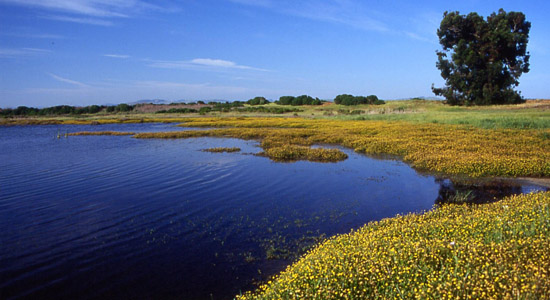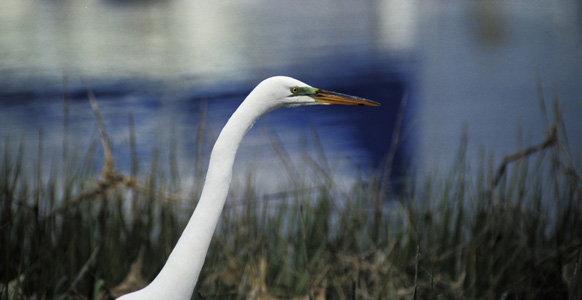We all love the Bay. Even if we just catch a glimpse on our commutes, we know itís there. Windsurfers, sailors, dog-walkers, runners, hikersóitís the visual signature of outdoor life here.

More wetlands will support a stronger food web for Bay Area birds and for fish and other wildlife. Photo by David Sanger
BY Kelly Cash
Published: October, 2011
We all love the Bay. Even if we just catch a glimpse on our commutes, we know it’s there. Windsurfers, sailors, dog-walkers, runners, hikers—it’s the visual signature of outdoor life here. But how healthy is it? This month a group of scientific experts released The State of San Francisco Bay 2011, which offers a report card of sorts on just how the Bay is doing.
There’s good news and bad news. First, the good. Pollutants like heavy metals from wastewater treatment plants have been greatly reduced, and much of the Bay is in much better shape than it was in the middle of the last century. But ‘legacy’ pollutants like mercury from the Gold Rush and PCB’s from the last century continue to linger, and so we must sadly limit our consumption of much of the Bay’s seafood.
As our climate changes and sea level rises, San Francisco Bay, the largest estuary on the West Coast, will need more wetlands around its perimeter—both to protect local communities from flooding as well as millions of dollars’ more of restoration projects like those that have gone in the ground over the past two decades. Andrew Gunther, project leader for the report, said, These wetland restoration efforts will likely be viewed in the future as the most visionary flood control projects in the history of the Bay Area. The same wetlands will help filter some of the most toxic urban pollutants coming off of the Bay Area’s driveways, roads, and parking lots as well, said the Estuary Partnership’s Director, Judy Kelly.
The bad news: The biggest threat to the Bay is the fact that its rivers and Delta are in a state of chronic man-made drought. Dams and diversions have dramatically reduced the amount of fresh water that reaches the Bay, cutting inflows by more than 50 percent in most recent years. Protecting the Bay’s ecosystem and recovering its fisheries will require the state to change policy and adopt state-of-the-art water management that protects the freshwater needs of both people and nature.
Other key findings in the report:
• Fish abundance and diversity are declining in all regions of the Bay except near the Golden Gate. Fish-eating birds like Brandt’s cormorants, egrets, and herons are not finding enough food to feed their young. More wetlands will support a stronger food web for those birds and for fish and other wildlife.
• The amount of spoils deposited in the Bay from dredging of ship channels and ports has greatly decreased, from 10 million cubic yards in 1986 to one million cubic yards in 2009. These spoils have been used to help restore the Bay’s wetlands: 2.7 million cubic yards to the Hamilton Wetland Restoration Project and 156,085 cubic yards to Bair Island.
• San Francisco Bay is benefitting from the work of volunteers: In 2010, 25,000 Bay Area citizens rolled up their sleeves to clean trash from and restore creeks and marshes in the nine Bay Area counties on Coastal Cleanup Day.
• Residential water use around the Bay has decreased, from over 100 gallons per person per day, to less than 80 gallons per capita per day. The use of recycled water has increased in the Bay Area, from 29.1 thousand acre feet in 2001, to 46.1 thousand acre feet in 2010. Water conservation by Bay Area residents and increased use of recycled water could leave more water in San Francisco Bay tributary rivers—but only if additional upstream diversions are not made.
The San Francisco Bay is one of the largest, most ecologically and commercially productive ecosystems in the world. It provides us tourism and commerce assets, as well as intangibles like peace and beauty. If we can find the will use water in smarter and smarter ways, both individually and as a society, we can make our Bay healthy again.
Kelly Cash is the Director of Communications at Aquarium of the Bay and has worked extensively on Working Lands and Waters Issues.

Fish-eating birds like Brandtís cormorants, egrets (seen above), and herons are not finding enough food to feed their young. Photo by David Sanger

